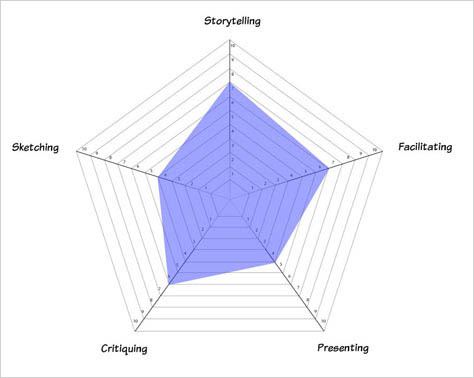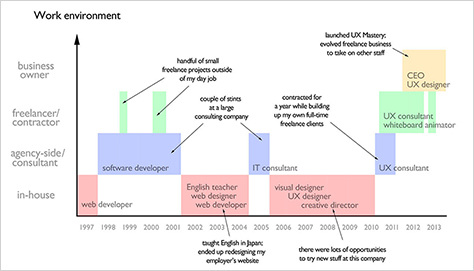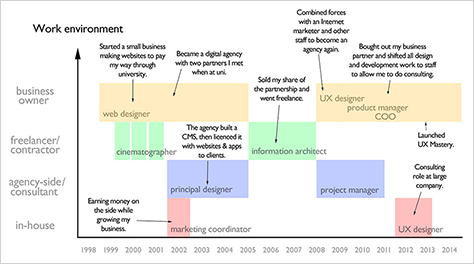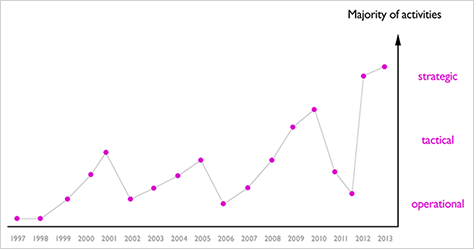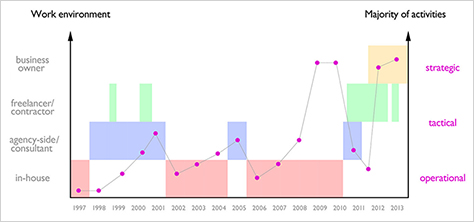Personally, I get excited by the variety that UX offers me: the breadth of design challenges and the range of activities that I get to engage in—with other people and on my own. I’ve learned over the years that I need that variety for job satisfaction. A job where I can apply my visual skills, my technical skills, and my people skills is one that I find incredibly rewarding. The fact that the outcomes of my work—Web sites, mobile apps, user interfaces—often empower the people using them is the icing on the cake.

What Is It About UX That You Are Drawn To?
Whatever your personal motivation to succeed in the field of UX, it needs to be more than the cash or the glory. Work out your why, and the challenges ahead will feel less daunting.
It might feel a bit contrived, but I have an exercise for you to try your hand at. I want you to put this ebook reader down—or minimize the window on your computer—pick up a pen and paper, and complete this sentence for me. Try to avoid referencing salary or recognition in your statement.
I want to become a UX designer because…
Write it down. Seriously, I’ll wait!
Oh, you’re back! Great. How did you find that exercise? If you found it particularly difficult, you may want to mull over the topic some more and refine it when you’ve crystallized in your mind what’s driving you. Having a sense of purpose equips you with the stamina you’ll need to navigate the inevitable difficulties that come with any career.
 Video: Knowing Your Why
Video: Knowing Your Why
Simon Sinek’s TED talk, Start With Why: How Great Leaders Inspire Action,![]() is an inspiring reminder of how acting with purpose in our personal and professional lives can lead to success, regardless of the field.
is an inspiring reminder of how acting with purpose in our personal and professional lives can lead to success, regardless of the field.
Performing a Self-Assessment
If you were redesigning a shopping cart, with the goal being to increase the number of sales the site processes, the first thing you’d need to know is how many sales it’s currently making.
Deciding how best to tackle your entry into User Experience is a lot like tackling a UX project itself—you need to have a baseline. Understanding where your skills are at now is a prerequisite to charting where you want to go.
There is no one “best” way to perform this self-assessment. We humans and the skills we possess are complicated! However, there are a few different approaches that have been devised specifically for thinking about a career in UX. Let’s look at a few.
UX Knowledge
Elizabeth Bacon’s sundial of User Experience fields![]() is a wonderful model for looking at the big picture and how your knowledge stacks up. To progress toward operating at a strategic, big-picture level—arguably the ultimate goal for all practitioners—one needs to be able to understand, define, and communicate a vast range of fields.
is a wonderful model for looking at the big picture and how your knowledge stacks up. To progress toward operating at a strategic, big-picture level—arguably the ultimate goal for all practitioners—one needs to be able to understand, define, and communicate a vast range of fields.
 reprinted with permission
reprinted with permission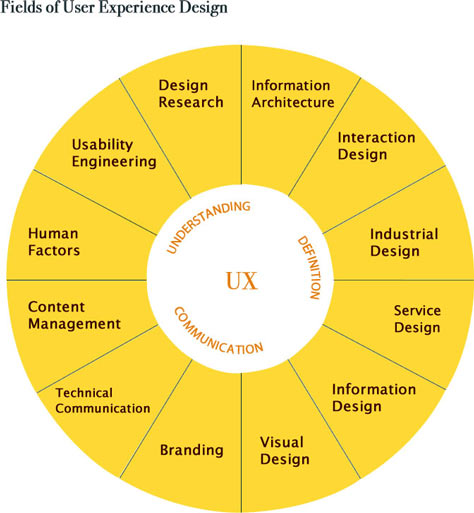
Of course, no one person can be expected to have in-depth knowledge of all of these subject areas. One of your career goals should be to become an expert in one or two of them, but maintain a balance across the entire spectrum. Here’s what Elizabeth’s self-assessment looks like.
 reprinted with permission
reprinted with permission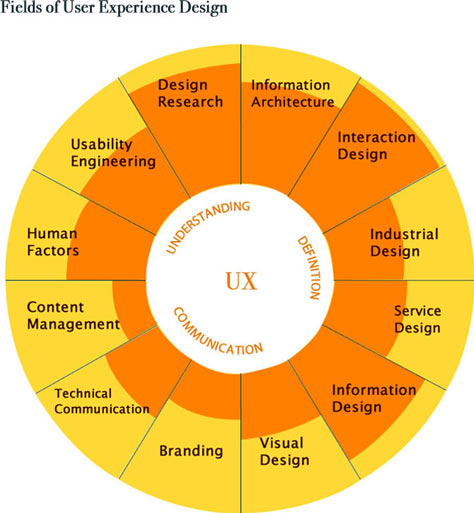
This paints a holistic picture of Elizabeth’s experience. As a senior designer, Elizabeth is clearly strong in interaction design and several closely related fields. She also has a good understanding of other areas, and this balance no doubt serves her well as she interacts with developers, business owners, users, content producers, and other team members involved in her projects.
The fact that all of these skills contribute to making a successful UX designer is an overwhelming prospect. However, the intent here is not to suggest that you should strive to become an expert in each one of these areas—more to give an indication of just how vast the UX umbrella really is.
For now, it suffices to say that, no matter how skilled you become in one area, there is always more to learn.
 Assess Yourself Now
Assess Yourself Now
Bundled with this ebook is a UX self-assessment kit. Print out the sundial and use it to perform your own self-assessment. There’s no need to get fancy with graphics software—just color in the wedges using a marker. Pin your self-assessment poster up in your cubicle or at home so you have it on hand as a reminder of the areas that you hope to develop.
Try it now: rate yourself in each of the following categories from 1 to 10, with 1 meaning “I’m a complete beginner” and 10 meaning “I’m an expert.” Answer honestly!
Soft Skills
Knowledge about a particular field is all well and good, but being able to apply that knowledge is another thing altogether. Jared Spool, founder of User Interface Engineering, deduced from studying a number of expert UX professionals that the five indispensable skills for UX mastery![]() were the softer skills of
were the softer skills of
- sketching
- storytelling
- critiquing
- presenting, and
- facilitating
You’ll notice that all of these skills are quite independent of the fields we just looked at. They’re not the type of thing you take a class in and master over the course of a semester; they’re life skills, and you work on them throughout your career.
In the fields in the previous section, in-depth knowledge of all fields is practically unattainable. However, it’s entirely within the realm of possibility that someone could potentially master all five of these soft skills. When visualized, your goal should, therefore, be to achieve maximum coverage rather than an even balance across the spectrum.
